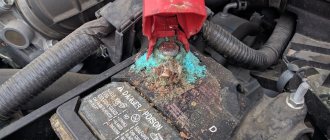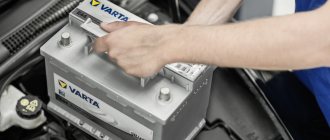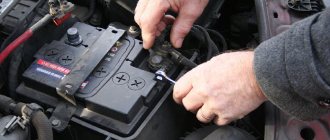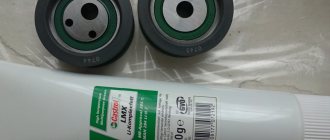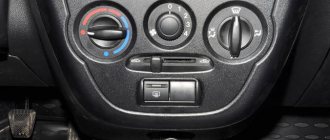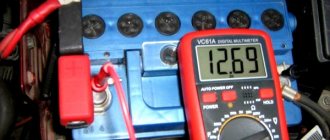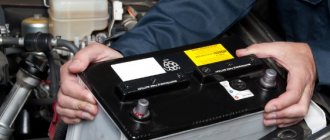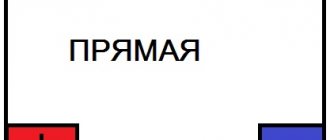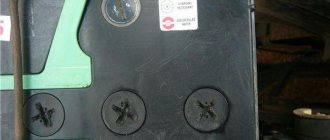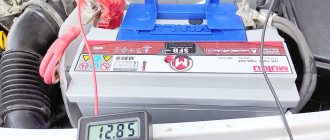Bad battery or poor contact with the battery?
Really, why won't the car start? The most common reason is indeed the battery. The car does not have enough voltage-current-charge, the starter clicks, but the car does not start. Battery, right? Yes, but not really. There are nuances:
1. The battery is really dead.
A kind person with a cigarette lighter cord will help you start the car, or you will have to connect the charger for 15 minutes, or a newfangled capacitor device found in your neighbor’s garage will help. We set off, but the question remained: “Why did the battery run out?” There are two options here:
- Maybe the battery has really expired, it doesn’t hold voltage, has a high self-discharge, etc. Charging doesn't help for long.
- The battery has discharged something, and after charging the battery, the car starts with a bang. We need to look for the reason. Besides the banal ones (the lights were on all night), there is one reason that even experienced drivers sometimes forget about: self-discharge directly through the dirty battery case. We will return to this reason shortly.
We recommend reading the article on how to extend battery life
.
2. The battery has a decent charge, but there is not enough current.
This means there is poor contact in the battery terminals, where the wires to the body and the starter are attached to it. And here are two options:
- The clamp on one or both terminals of the battery is simply not tightened, it dangles, and is easily turned by hand. Turn it a little in one direction or the other, pressing down so that it sits deeper, tighten the bolt and - go ahead!
- The contacts have oxidized, or even become completely covered with an unsightly layer of oxides. Oxides do not conduct electric current well, and their layer can greatly increase the resistance of the starter power circuit, making the normal starting current unattainable. To leave, clean the terminal and clamp with improvised means (knife, rag), attach the clamp, slightly twisting it (as in the previous case) and tighten it. The car should start.
But remember, this is only a temporary measure, and the battery persistently requires your attention.
There is a video waiting for you at the very end of the article!
Time-tested lubricants
The most popular is solid oil (as an option - Litol or Nigrol), used by our grandfathers. After tightening the terminals tightly, they are lubricated with a thin layer - and for six months you are guaranteed against problems (if the seal is not broken, there is no breakdown, etc.).
Second place among traditionalists is occupied by Vaseline - both technical and regular pharmacy. But, if solid oil is accepted in principle even by supporters of innovation, then Vaseline is in great doubt among them. It protects the terminals well from moisture and to some extent prevents them from being “soldered” to the battery, but it has difficulties with conductivity. To overcome them, many people add graphite lubricant to Vaseline.
Method for the lazy:
When checking the oil level, apply a dipstick to the terminals. Since the level is checked frequently, the lubricant is updated regularly, and the battery will not require maintenance soon - again, if it does not have the “personal” problems described above. Although it is still worth cleaning it from dust occasionally.
If solid oil is selected.
From generation to generation, novice car enthusiasts repeat the same mistake: they apply it between the battery terminals and wires. They forget that high temperatures (which cannot be avoided) cause solid oil to set and harden.
As a result, a dry, very dense crust is formed. It does not conduct current, as a result of which contact is lost. And it is extremely difficult to clean it off! By the way, the warning also applies to other lubricants: problems with them are less difficult to fix, but just as unpleasant.
General reason, or a little theory
Self-discharge and oxidation of battery contacts,
turns out to be interconnected. The reason for these phenomena is the combination of water, dirt (dust) and sulfuric acid from the battery itself on the surface of the battery and its contacts.
Sulfuric acid
- this is an integral part of the battery electrolyte, it tends to slowly evaporate, this process is called electrolyte leakage (especially when the battery almost boils under the hood of a hot car in the summer), and can also leak where the contacts exit the housing. Sulfuric acid vapor loves water and immediately combines with it, forming a solution of sulfuric acid. Let's remember this.
Dust, dirt, moisture
- they are always under the hood and over time they cover any surface there with a durable coating, including the battery and its contacts. Water holds dust, dust holds water - in general, there is always water in this coating. It dissolves some of the dust, and then in the area of the battery, sulfuric acid is added to it - and this is no longer water, which in its pure form does not conduct electric current, but a conductive solution, an electrolyte, almost the same as in the battery.
It is not for nothing that experienced craftsmen never install or remove a used, not new, battery without protective clothing and gloves. It seems like I didn’t touch the battery with my pants, but lo and behold, a few days later, out of nowhere, a hole appeared. The acid ate away, slowly but surely.
Lubrication as a remedy?
Actually, if the terminals and contacts have already oxidized, then lubricant is useless here; it will not remove them. First you need to clean all the elements of contamination, and “clean”, many say “to a shine”, and this is both the terminal and the contact itself, and only after that you need to lubricate it! And only then will the protection work; it will really prevent it from being covered with plaque. There is only one purpose - to displace water and create protective properties on the surface.
Another important question is which one to take, in a tube (that is, in the form of a thick lubricant) or in the form of a spray. The question here is not clear-cut; auto electricians recommend lubricant, that is, you need to squeeze it out “like a paste” and physically spread the contacts; the work can be done with gloves. Aerosols also have a place, however, when sprayed, it can get on the surface of the battery, which is also not very good, so after spraying on the desired surface, we clean all other places.
Self-discharge through the battery surface
It turns out that even a thin layer of plaque or dirt on the battery, if it is not completely dry, can conduct electric current. And here is the battery discharge line in wet weather - from one battery terminal to the other right along the surface of the battery. The discharge current is weak, but lasts for days and nights, weakening the battery.
Have you noticed that such incidents with cars not starting often happen when the weather changes, when the car sits in the rain for a couple of days and picks up moisture.
What to do?
Regularly clean and wash with car shampoo the surface of the battery on top and near the terminals. Cover the surface of the terminals and terminals on them with a protective compound that does not conduct electric current. We will talk about these compositions below.
What exactly does lubricant do?
If an oxide film forms on the terminals, the engine may not start at all. This often happened on old cars, for example, Zhiguli. The positive terminal on the “classic” often acted up and quickly became dirty. The driver had to clean off the plaque each time with a knife, screwdriver or fine sandpaper. At the same time, the battery was fully charged, but the starter required a strong current, and the slightest resistance instantly took all the voltage. In addition, oxidation contributes to the self-discharge of the battery.
What does lubricant do? If the terminals have already oxidized, then there is no point in applying the substance to them. First you need to clean them to a shine, connect the battery, and only then apply lubricant for preventive purposes. These agents work well to prevent oxidation, although they are unable to eliminate it. The purpose of the lubricant is to protect and “preserve” the battery terminals, preserving their original properties. This will prevent you from having to get rid of oxides and dirt mechanically in the future, which is not very pleasant and takes a lot of time.
Formation of oxides on the terminals
Oxidation of battery terminals
The terminals of most lead acid batteries are made of lead, the same metal found in the battery. Lead easily reacts with sulfuric acid, various salts from the surface wet layer, and is also easily oxidized by atmospheric oxygen. The positive potential of the positive terminal of the battery relative to the environment only accelerates the destruction of the terminal. That is why it is on the positive terminal that all these multi-colored crystals most often grow.
What to do?
It is good to clean the contact area (until shiny) and the entire clamp with emery cloth, a wire brush or files, rinse with distilled water or gasoline, and dry. Apply a thin layer of protective compound (there are also recommendations to apply protection only after connection). Place the clamp with a rotating motion to remove grease from the contact area. Tighten the bolts. Additionally, coat the surface of the assembly with the composition.
Remember, protective compounds only protect, not clean. Therefore, it is up to you to carry out high-quality cleaning, on which the result of the entire operation depends. And the task of lubricants is not to eliminate the consequences, but to prevent them.
New types of lubricants
Now special compounds have been developed specifically for terminals, which can actually improve not only the protective properties, but also the conduction of electricity. Actually, there are a lot of compositions; every reputable company has one of these.
They are specially tinted with blue or red colors so that the treated surface can be distinguished.
- LIQUI MOLY. Technical Vaseline with improved characteristics, colors the terminals red.
- VMPAuto MC1710. Colors the terminals blue. Let's watch a short video
- Molykote HSC Plus. This composition improves electrical conductivity and also withstands low and extremely high temperatures (up to + 1000 degrees).
- Ciatim. Russian manufacturer, the cost is not high, but close to Litol.
BUT any lubricant must be applied correctly otherwise you will simply do more harm than good.
What are the dangers of oxidation?
If you do nothing, the following problems are possible:
- Difficulty starting the engine. This malfunction is typical for cars of domestic brands. Most often, the “positive” terminal suffers, which turns out to be contaminated.
- Decrease (dip) in on-board network voltage during engine start-up. When you turn the ignition key, the starter consumes more than 100 Amperes of current, so even insignificant resistance creates problems and “pulls” the voltage onto itself.
- The effect of self-discharge of the battery occurs. The reason is the appearance on the surface of the product of an oxide film capable of conducting electric current.
It is better to treat the terminals in advance, even on a new battery, without waiting for oxidation to appear.
Where to lubricate, outside or inside
The lubricant should protect the battery terminals from oxidation while maintaining the transmission of current through the contact surfaces. Some copper-based products are applied to the pins before connecting the battery to the vehicle's on-board network.
Battery terminal lubrication
It is recommended to pre-clean the surface mechanically, install the wire terminal blocks, and then treat the surfaces with a protective lubricant. Some protective preparations contain dielectrics; getting the substance between contact surfaces impairs the conductivity of electric current.
When to lubricate
It is necessary to smear the battery terminals not when a layer of white oxide has already appeared, but preferably before installing the battery or at least at the very beginning of the process and the appearance of oxidation products.
On average, terminal maintenance measures are required every two years. On modern maintenance-free batteries that do not require so much attention, the need to lubricate the terminals may arise after 4 years.
By and large, it all depends on environmental conditions, the condition of the electrical wiring and battery. Since damage to the terminals, poor contact, overcharging from the generator, violation of the seal of the housing and the ingress of technical fluids only contribute to the formation of plaque.
How to properly lubricate terminals
Of course, you cannot lubricate the terminal without a wire in place. This must be done on an already connected version in order to ensure the most effective contact of metal surfaces. Thus, internal lubrication is a priori eliminated and it is necessary to treat the battery terminal with a dielectric from above, when the tips are already secured.
Article on the topic: How to change the thermostat on a VAZ car with your own hands
According to the instructions, lubricant is applied to the terminals as follows:
- The battery terminals and the internal parts of the tips are cleaned of dirt and oxides with fine sandpaper or a special metal brush - you can also use a brush soaked in a soda solution;
- the wire lugs are put on the terminals, tightened tightly - there should be no looseness;
- lubricant is applied to the upper ends of the battery terminals;
- the resulting “cap” of the chemical composition is slightly leveled.
Old-fashioned methods of lubrication of terminals
In those days, they didn’t sell a variety of beautiful tubes of auto chemicals. What was available, at hand - that’s how we dealt. These methods still work today.
- Felt and oil
- Indeed, from our grandfathers, the method has been known for a long time. A ring of the required dimensions is cut out of thin felt, soaked in machine oil and put on the cleaned terminal. The clamp is put on with a twist to increase the contact area. Sometimes the top of the knot was covered with an additional plate of oiled felt. The entire surface of the metal was lubricated with oil. - Consistent oil
- If liquid machine oil was used in the previous method, then the entire contact assembly was covered with thick oil - grease, lithol, nigrol, petroleum jelly, without felt. There is a certain difference of opinion here - some consider this method to be the best, while others accept it as a temporary measure until it becomes possible to use a modern means. Of course, this is not what oil is intended for. But if you clean and recoat the contacts twice a year, the method works. - Copper grease
- Both the grease is rare and the method is rare - but effective due to the special properties of copper grease. These are stability of characteristics, viscosity, antioxidant properties. - Wax (paraffin)
is an effective option; it is a good dielectric and also adheres well to the surface of terminals and clamps. - Silicone
is a material that can be given a variety of properties. As a terminal agent it has certain advantages. Silicone is resistant to aggressive environments and water, and can operate at temperatures from -60°C to +180°C. It is important that it is silicone grease without conductive additives.
Silicone coating requires constant monitoring and frequent processing.
Do the terminals of modern batteries oxidize?
Lead alloys are used to make the contact pins of modern car batteries. The parts undergo additional mechanical processing to reduce the number of cavities on the surface.
Some manufacturers install metal protective sleeves made by third-party manufacturers.
Metal protective sleeves
The use of seals and reduced emissions of fuel and engine oil vapors into the engine compartment further reduced contact corrosion. But oxides on the surface of pins and contact terminals are formed from constant contact with oxygen, which is part of the atmospheric air. Even when using a special protective coating, oxygen molecules interact with the metal of the contact plates, forming a layer of oxides.
People's rating of the best remedies
Among the huge number of products on the market, we will highlight the most popular, time-tested protective lubricants for terminals.
HSC Plus from Molykote
Electrically conductive lubricant based on mineral oil with a thickener, containing metal powder. Works in a wide temperature range. Available in paste and aerosol form.
Ciatim 201
Universal instrument lithium grease, frost-resistant and refractory, inexpensive.
Batterie-Pol-Fett from LIQUI MOLY
Special lubricant for battery terminals. Synthetic acid-resistant Vaseline, red in color. Completely blocks the access of moisture to the contact area. Reduces contact resistance.
Battery Pole Spray by Berner
Specialized aerosol for battery terminals. Improves contact. Well protects against corrosion.
MC 1710 from VMPAVTO company
Lubricating paste for terminals. Apply only to the dressed terminal. Protects against corrosion (contains additives), creates a protective film.
BATTERIE-POL-SCHUTZ from Presto
Protective aerosol. Does not allow sliding discharges, protects against corrosion. Blue color.
Kupfer-Spray from LIQUI MOLY
Universal copper spray for high temperature connections, also suitable for terminals.
What products are used for protection and treatment?
The main purpose of lubricants is to protect contacts and elements that are made of lead. It doesn’t hurt to understand why battery terminals oxidize and require reliable protection.
Reasons for frequent oxidation:
- lead is extremely susceptible to such effects;
- aggressive environmental influences aggravate the situation;
- Leaks regularly occur on serviced models;
- older cars were made with copper terminals, but the contacts are made of lead, as a result oxidation occurs faster.
Among other useful functions of lubricants, improvement of electrical contact stands out. Modern products are distinguished by such properties. When thinking about how to lubricate battery terminals for better contact, you should pay attention to the latest developments. They differ in characteristics; they paint blurred areas in a certain shade - blue, red.
Popular formulations:
- Liqui Moly is a famous manufacturer that produces reliable lubricant, similar to technical Vaseline.
- Molykote HSC Plus is a product suitable for different drives. It is characterized by high electrical conductivity and the ability to operate under significant temperature fluctuations.
- VMPAuto MC1710 is a substance that helps maintain stable voltage. Easy to apply.
- Cyatim is a domestic product that attracts with the most affordable price. Its properties are similar to Litol. Therefore, conductivity is insufficient.
Traditional methods are presented:
- felt pads pre-soaked in oil;
- apply grease, technical petroleum jelly with graphite lubricant;
- washers, felt gaskets;
This provides excellent protection, including from moisture, and eliminates soldering of terminals. Problems can arise at very high temperatures when the solid oil hardens. Therefore, it is preferable to use modern means, aerosols.
Timely care and selection of appropriate materials allows you to preserve the battery life and its properties. Using cleaning products will help fight oxides if they already exist. They must be removed, otherwise the protective equipment will be useless.
The cleaning process includes several stages:
- The power plant is switched off, which prevents a short circuit. It is important to remove all metal jewelry from your hands.
- Depending on the outputs, the required key is selected.
- Work begins by loosening the nuts, which allows you to remove the terminals. It is important to remember how to disconnect the battery terminals - work begins with the negative terminal to avoid short circuiting.
- After disconnecting the positive terminal, the battery is inspected for damage. And if there are signs of wear on the wires and elements, replacement will be required.
- A soda solution allows you to remove traces of electrolyte vapors and oxides. To do this, dilute a teaspoon of soda in a 250 ml cup of water.
- Using a brush (tooth or wire) you can easily remove unwanted deposits.
- After complete cleaning, the terminals and the drive are washed with water. It is noteworthy that on a clean device, oxides appear more slowly.
The final step is to connect the battery terminals and process the cleaned areas. When connecting, it is worth remembering that the positive terminals are connected first.
Emergency care
If you don’t have time for thorough treatment, you should use emergency cleaning products. They differ in their mode of action and characteristics. Therefore, it is important to study the instructions and not forget about protective equipment.
If you don’t have any tools on hand to carry out the work, you can use regular cola. You will need to prepare protective gloves and select a wrench.
Main stages:
- The terminals become loose and cannot be removed.
- Cola flows from the center of the battery to one and then to the other edge.
- After 2 minutes, the device and contaminated areas are washed with water.
- The terminals are tightened.
When treating connections with lubricant, there is no need to coat the terminals and contacts separately. Protection is applied after connection.
Timely maintenance of the drive, its elements, connections, removal of contaminants and oxides allows you to maintain good contact. Otherwise, it cannot be ruled out that the terminals will melt. More often this happens in the summer. There are several options to solve the problem. You can replace the terminals or think about how to restore the terminal on the battery yourself.
Methods for self-recovery:
- A AA battery is made into a mold by melting lead and tin and the cell is restored. This solution is only suitable for partially melted elements. Before performing the procedure, the fusion site is cleaned and a mold is put on.
- Lead fusion is used if the terminal is completely destroyed. Take the core and shell of the battery. The method is suitable for recovery on the road.
- If an element breaks off, restoration can be carried out using self-tapping screws. Take pieces of equal size and drill holes in them, no more than 5 mm in diameter. Next, use a conductive lubricant necessary for processing the planes, connect them with a screw or self-tapping screw.
Correct operation, cleaning, and care of the battery helps to avoid unpleasant incidents.
It is recommended to lubricate the car battery terminals. But first we need to clarify: why perform this procedure?
It is recommended to lubricate the car battery terminals. But first we need to clarify: why perform this procedure? Lubricant is applied to avoid oxide formation. It is a white coating. In essence, we are talking about oxidation caused by exposure to an aggressive environment and, first of all, electrolyte vapors. During the first stages of battery operation, the formation of oxide is almost invisible. But gradually the appearance of a white coating negatively affects the performance of the battery. As a result, current leakage begins to occur, which leads to rapid discharge and difficulty starting the power unit.
If the car owner ignores this problem for a long time, then the terminals will need to be changed or restored. Let's look at how you can avoid this situation.
If you choose a large online store, the buyer will be able to find more than 10 different formulations. But practice shows that only a few effectively cope with the task.
In which case the question arises: how to lubricate battery terminals to prevent oxidation?
to achieve a positive effect and not spend extra money?
Reviews indicate that from the numerous compositions, no more than 5 can be identified that really deserve attention. The main criteria for evaluation are:
- possibility of operation at low and high temperatures;
- efficiency. We are talking about protective characteristics that protect the terminals from corrosion processes;
- ease of use;
- duration of effect;
- elimination of discharges.
The table shows the TOP 5 lubricating compositions with high acid resistance, tightness and viscosity. Here you can see the temperature range during operation.
When selecting an effective composition for battery terminals, it is recommended to take into account the following parameters:
- resistance to acids. The substance should minimize the level of formation of oxidative processes;
- viscosity level. It is one of the most important properties. Since the device is operated at high temperatures, lubricants decompose. Therefore, with a low or medium viscosity of the composition, the car owner will have to frequently apply it to the surface of the terminals;
- temperature Range. The vehicle can be operated at low and high temperatures. Therefore, the lubricant must perform its functions throughout the year. At the same time, the viscosity level should remain high;
- protection from moisture and oxygen. This parameter must be understood as tightness;
- dielectricity.
Not all lubricants meet the listed requirements. Some of them protect quite well from condensation and exposure to oxygen. At the same time, they have insufficient viscosity.
Other lubricants have high acid resistance, but are not designed for use over a wide range of operating temperatures.
It must be emphasized that in the parameters listed there is no consideration of the basis. Before purchasing a lubricant, it is recommended that you familiarize yourself with this criterion.
This foundation is practically perfect. It can be used during operation from minus 60 to plus 180 degrees. The silicone base flawlessly displaces condensation, prevents oxidation processes and has impeccable dielectricity. At the same time, all silicone-based lubricants have a fairly significant drawback - high fluidity. Therefore, a car owner who chooses such a lubricant will have to often look under the hood and apply it to the surface of the terminals. When purchasing such a composition, you need to pay attention to the absence of conductive components.
The products of the German brand Liqui Moly are especially popular among car owners. The composition of the Presto brand, the cost of which is much lower, in Liqui Moly has good performance characteristics. The photo shows lubricants for battery terminals of the indicated brands.
Silicone is used as the main component of such substances. Some sources claim that Teflon lubricants are excellent for protecting battery terminals from oxidation. In fact, the substance in question is a “liquid key”. It has high penetrating ability. Therefore, Teflon lubricants need to be used for other purposes, and to protect the terminals from the appearance of white deposits, it is recommended to look for other substances.
To protect battery terminals, polymer-based and organic-based products can be used. A polymer or synthetic base is ideal for protecting moving elements. In this case, the task of the product is to provide maximum protection against oxidation. Therefore, it is better to choose a mineral base and focus on additives. It should be noted that the presence of various types of additives demonstrates maximum efficiency in protecting terminals from corrosion processes. The most common mineral-based lubricants are the following:
- Vaseline is a paste-like liquid. Depending on the level of cleaning, it can have a translucent color, as well as black and yellow. The main components are mineral oils and paraffins. The product is used in the medical industry and the technical segment. To lubricate the terminals, you can use all types of Vaseline, but experts recommend using a translucent composition, which can be purchased at almost any pharmacy. If the composition in question is dark in color, then most likely it is intended for technical purposes. It must be applied only with gloves, avoiding contact with exposed skin. The composition has a high melting point. Resistant to electrolyte and moisture. Therefore, it copes well with the assigned tasks, protecting the battery terminals from oxidative processes;
- Cyatim 201. This substance does not conduct electricity and dries quickly on the surface. Resistant to low temperatures;
- Solid oil. This material is highly resistant to moisture and has a high level of fire safety. A significant disadvantage of the lubricant is the increase in fluidity when the temperature rises to plus 65 degrees. It is recommended to use only if there are no other means available from the car owner.
Litol can also be used as a lubricant. It has approximately the same characteristics as solid oil. Both lubricants are oil-based. It should be noted that many car owners still use these products, despite the abundance of modern compounds.
Among modern products, it is necessary to highlight the LIQUI MOLY KUPFER-SPRAY spray. It is designed for operation at temperatures from minus 30 degrees to plus 1000. The aerosol contains mineral oil. According to the instructions, this aerosol is intended for treating brake pads. However, it can be used for battery terminals. During the application of the spray, it is recommended to cover the area around the terminals with tape.
Especially for terminals, Liqui Moly produces Batterie-Pol-Fett, which paints the surface red. The substance can be used at temperatures from minus 40 to plus 60 degrees Celsius. Reliably protects the metal surface from corrosion processes. According to its physicochemical characteristics, the composition in question is technical petroleum jelly. Also, in accordance with the manufacturer’s instructions, it can be used to protect connectors and contacts of a vehicle’s electrical network.
Vmpauto MC1710 spray is made on the basis of organic and polymer oil combined with silicone. The product is intended for use at temperatures from minus 10 to plus 80 degrees. It is considered a fairly effective means of protection against water and aggressive environments.
Batterie-Pol-Schutz substances are produced by the Presto brand. The main component of the composition is wax. Designed to protect against corrosion processes and moisture oxidation. The manufacturer claims that when using Batterie-Pol-Schutz, the power of the battery is not reduced, and the occurrence of sliding discharges is also excluded. The substance can be used at temperatures from minus 30 to plus 130 degrees Celsius. Sold in aerosol cans.
In general, all wax-based lubricants, of which Batterie-Pol-Schutz is a representative, have many advantages:
- maximum retention level;
- high tightness;
- absence of stray discharges.
For these purposes, consistent substances are used, which contain special thickeners. Such compositions consist of almost 90% polymer or organic oil. Additional elements are additives and other components. A fairly popular product is Molykote HSC Plus lubricant. Unlike other compositions, the product in question is intended to improve electrical conductivity. The composition also has high performance characteristics and can be used at temperatures from minus 30 to plus 1100 degrees.
The paste in question for battery terminals is sold in 100 ml tubes. It must be emphasized that the increase in electrical conductivity of Molykote HSC Plus paste is quite an important advantage and sets it apart from its competitors.
Among professional car owners, lubricant with copper pigment, based on organic or polymer oil, has become widespread. An example is Berner grease, which can be used at temperatures from minus 40 to 1000 degrees. The product is sold in the form of an aerosol can. Just like Molykote HSC Plus, it has high conductivity and also provides protection:
- from corrosion;
- oxidation.
The improved composition reliably protects the battery terminals from oxidative processes and the effects of electrolyte vapors. The composition has a red color, which is due to the presence of copper pigment.
On specialized forums you can find information that some car owners use graphite-based lubricant to protect terminals. Such data is unreliable. It is necessary to highlight three characteristic features of graphite-based lubricants:
- high level of resistance;
- temperature increase when current passes;
- operation at temperatures from minus 20 to plus 70 degrees.
Therefore, the lubricant is not intended for use on terminals. Moreover, under certain conditions, overheating and fire are possible. Considering the listed features of graphite lubricant, it is not recommended to use it for processing terminals.
It is recommended to apply lubricant before installing the battery. The car owner does not need to wait until a white coating forms on the surface. The procedure does not require frequent intervention: it is enough to apply lubricant once every 2 years. If we are talking about a maintenance-free battery, that lubricant may well last for three to four years. The frequency of application of the composition depends on several criteria:
- battery;
- operating conditions;
- condition of the vehicle wiring;
- environment.
If, as a result of cleaning the metal surface of the terminal, traces of oxidation appear again, then using a lubricant will not help. Most likely the problem is overcharging or a crack.
The work on cleaning the terminals involves the following algorithm:
- dismantling terminals;
- cleaning the surface with felt or a brush. A soda solution will help simplify the procedure;
- rinsing with distilled water;
- installation and treatment with lubricant.
To treat the surface, you can use various means depending on the degree of oxidation:
- fine-grained sandpaper. It is recommended to use it, since no abrasive particles will remain on the surface;
- Toothbrush. This tool is relevant to use only if the car owner plans to carry out preventive maintenance. The same goes for dishwashing sponges;
- felt is one of the best materials for removing traces of oxidation;
- special scraper (shown in the photo below);
- special brushes. Such devices can be purchased at a specialized online store. Products from the Toptul and Autoprofi brands are distinguished by high-quality workmanship;
- soda solution. To prepare, you will need about a quarter liter of distilled water and 1.5 tablespoons of baking soda.
If thorough cleaning of the surface is required, you can use a drill and install a special brush attachment. It is not recommended to apply significant force when using a drill. Removal of traces of oxidation is much more effective with little effort.
Before performing work, it is necessary to assess the condition of the terminals. If a white coating has just appeared on the surface of the metal, then it is quite enough to use a soda solution and felt. In exceptional situations, you will have to resort to using a special tool.
The terminals of any battery are regularly exposed to the negative effects of aggressive environments. As a result, oxidative processes occur, which are reflected in a decrease in battery performance. The motorist's task is to ensure the functionality of the battery and protect it from aggressive influences. Therefore, it is necessary to choose a lubricant wisely. As noted, the composition must conduct current and have high tightness and viscosity. The article lists the most popular and effective means. But their use is relevant only in cases where the situation is not brought to an extreme.
We invite you to watch the video, which discusses the most effective means for protecting terminals. The material discusses the main reasons for the appearance of white deposits on the terminals and ways to eliminate them.
Car owners will be able to directly familiarize themselves with the catalog of modern lubricants. The catalog presents effective products from well-known and little-known brands. Buyers will be able to purchase oil- and silicone-based lubricants, lubricating pastes and other compounds.
The cost of a product depends on a number of criteria, from the brand to the composition. The method of application also matters. For example, Presto Batterie-Pol-Schutz of the Dutch brand will cost the buyer from 1600 to 1900 tenge. Molykote HSC Plus conductive paste in a 100 ml container costs approximately 5800 tenge. Products from the famous brand Liqui Moly are presented in a wide range. Silicone lubricants in disposable bags can be purchased for 450-550 tenge. In general, the purchase of expensive products in large volume containers is relevant for specialized services.
For the average car owner, a small tube is quite enough, especially since under standard conditions the product will need to be used once every few years.
A car battery is quite a “thin” and very capricious thing; if used incorrectly, it can be damaged in a matter of days. Of course, now technology is moving forward, more and more advanced types are being produced, for example Calcium options, it’s worth it. BUT the same terminals protruding from above remain unchanged, but they are in a fairly aggressive environment - this includes heat (in summer), moisture (autumn, spring), snow and cold (in winter). They can also become covered with dirt, oxides and other “delights”. Therefore, in order to protect them, it is advisable to lubricate them with protective compounds. Just what? And how to do it correctly, let's figure it out...
Actually, they started lubricating the terminals a long time ago, and before that there were no special lubricants, everything was done almost with improvised means. BUT realistically, why are they doing this? Why lubricate battery contacts?
Why does the terminal get hot?
Quite large currents flow from the battery to the starter, and then from the generator back to the battery. Just think - starting currents, in winter, can reach up to 600A. If you install a thin wire, it will simply not be able to cope with such a load and will melt before your eyes. This is why the wires are so thick and solid, all because they are designed to carry high loads.
Let's watch a short video.
There are not many reasons and they are all banal:
- The problem is in the terminal itself. There is poor contact between the wire and the fastener, sometimes it comes straight from the factory, a manufacturing defect (for example, the hole in the terminal is 10 mm, and the wire is 8 mm).
- It happens over time that water can get into this place or oxides can form. The bottom line is that wires and fasteners are often made of different metals, the potential difference sooner or later leads to oxidation of the contact point and the current conductivity drops significantly.
- Oxides between the terminal and the current terminal. This also happens, but rarely, if the contact is bad, then the current must pass through a very narrow point of contact. Warming up can come from here.
- The wire. Sometimes the wire itself suffers, say, from an accidental break in the middle that is not visible to the eye. That is, several threads were broken, and the load that he could bear decreased.
Poor contact with body. Often it is the negative cable and after the terminal that get hot. This is because it is bolted to the car body, and then both the starter and the generator are “powered” from the body. On modern foreign cars, the negative cable is quite short (on some cars it is attached to the engine block). So, the cable will heat up, but you will mistakenly think that it is the terminal (although with such a malfunction, the braiding of the wire itself will most likely begin to recover).
The positive terminal can only heat up from poor contact or, again, from oxides that have formed between the mount and the current terminal.
Old processing method
What did you use before? Mainly Lithol (Nigrolom). This is a technical lubricant designed for processing a variety of components.
The second most common is technical and even “ordinary” Vaseline. Its consistency also helped to form a protective layer.
However, these two treatments cannot be called highly effective; after all, LITOL and VASELINE conduct energy poorly and do not contribute to maximum efficiency. Therefore, if they got between the contact and the terminal, then the efficiency dropped significantly. Another disadvantage is that the film that formed on top was not so effective and was washed off (contaminated) very quickly.
How to lubricate the terminals to ensure contact and protect them from oxidation?
Let's consider what actions to take to prevent the terminals and wire tips from oxidizing.
Here it is worth highlighting several groups of products:
. This implies the use of time-tested lubricants - Nigrol, Litol or grease. After cleaning the terminals and pulling them tightly, a lubricating compound is applied to the surface. With proper processing, reliable protection against breakdown and leakage for 6-8 months is provided.
is another effective means of protecting against potential oxidation problems. The use of technical and pharmacy versions of the product is allowed. But many experts are skeptical about Vaseline (unlike grease). The reason is that it protects the metal surface from moisture and prevents the terminal from sticking to the battery terminal. The main disadvantage of Vaseline is its high resistance, which causes problems with conductivity. To avoid complications, it is recommended to add a graphite-based lubricant to the composition.
. This method of protection is intended for the laziest car owners who do not want to spend time looking for lubricant or money to buy it. Each time you check the oil level, apply a small amount of oil to the terminal (to prevent the terminals from oxidizing). If you do this work regularly, the battery will not need maintenance soon.
. This option is considered one of the simplest and most accessible. But many car owners make a mistake - they apply a lubricant between the wires and battery terminals. Subsequently, under the influence of high temperatures, the lubricating composition hardens and sets, and a dense and dry crust appears. Its peculiarity lies in the inability to conduct current, which increases the risk of loss of contact. In the future, cleaning off the hardened composition is a real problem. By the way, such difficulties can also be encountered when using other lubricating compounds (including modern ones).
